
Healthcare marketing is a critical aspect of the healthcare industry, aimed at improving patient engagement and experiences. In this blog post, we'll explore healthcare marketing, and the impact that a robust marketing strategy has on increasing growth.
In today’s digital age, healthcare marketing has evolved from traditional methods to include a wide range of digital channels and tactics. But what exactly is healthcare marketing, and how can you make the best use of it? We’ll dive into the basics of healthcare marketing, its benefits, and how you can leverage the power of digital marketing to skyrocket growth for your healthcare organization.
As we said, healthcare marketing is multifaceted. The goal is to increase awareness of medical conditions and treatments, build trust with patients, and guide them through their unique journey. These feats are achieved through digital strategies to increase patient engagement, build reputation, and garner great patient experiences to help strengthen brand trust and credibility. With the healthcare industry growing more competitive by the day, healthcare marketing has become an essential tool for providers to reach potential patients.
Healthcare marketing provides many benefits for healthcare providers. An efficient marketing playbook can give providers the upper hand by attracting and retaining patients. By keeping patients engaged with relevant, personalized, and timely outreach, providers can improve loyalty and increase the likelihood of repeat business. Healthcare marketing can help providers bring in quality leads, rake in revenue, and maintain healthy profit margins. By connecting with patients across multiple channels and using comprehensive data analytics, providers can continuously measure and adjust their strategies to optimize performance and achieve business goals!
The ultimate goal is to drive more qualified leads, generate revenue, and maintain healthy profit margins to boot! To achieve this, healthcare marketers use multiple channels to reach patients and use comprehensive data analytics to evaluate their performance and tailor their strategies accordingly.
When creating a healthcare marketing strategy, you first need to develop a website that can easily integrate new acquisitions and support patient acquisition goals.
When building a website for your multi-location business, you need to consider both immediate and future growth goals. Think about where your website will fit as you expand to new regions and open new locations. Consider the functionality and flexibility you’ll need in the next six months, one year and two years.
Consider how your website will look and function across all your locations and brands. Keep in mind that even if you encounter technical problems such as the need for custom coding, it doesn’t mean that you can’t grow. These are problems that can be fixed, but evaluate how much time and money it will take to fix them.
Successfully MSOs have a framework in place that supports their SEO strategy. SEO-friendly websites help search engines discover, crawl, index, and rank your website. While it can seem overwhelming, it’s not impossible. By following best practices, you can build a website that can scale with your business and ensure potential customers easily find it.
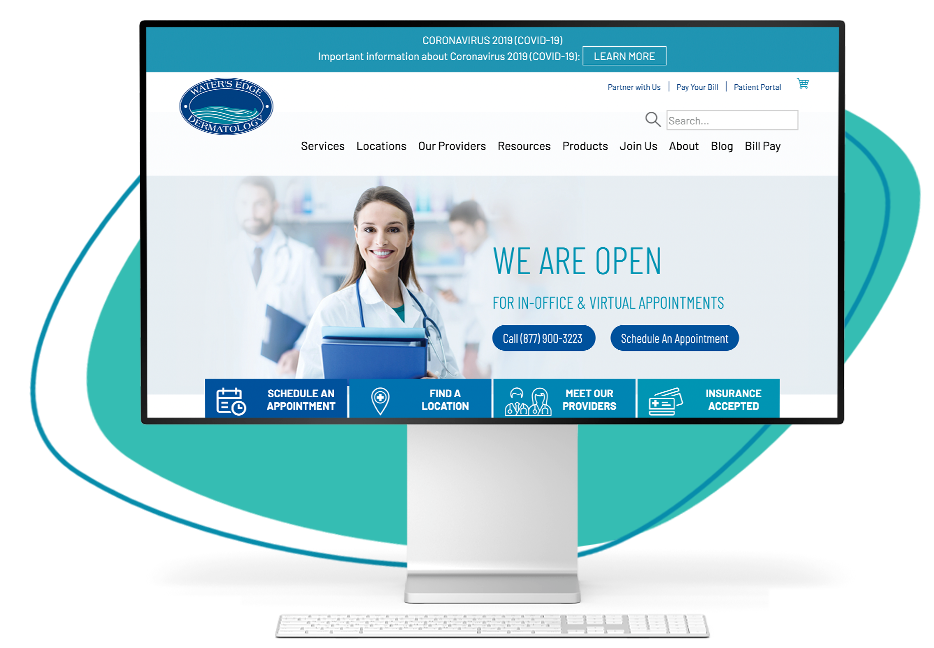
Cardinal created one landing page template for each core service area at Water’s Edge Dermatology. This gave them a flexible and scalable way to add new pages as they acquire new locations. We ended up creating around 200 landing pages that were not only visually pleasing but also easily customizable.
Strong SEO Foundation & Ongoing Optimization
When creating a website, take into account how to optimize it for search engines like Google. A visually appealing website is great, but if it doesn’t rank well on search engines, it will be difficult for potential patients to find. To ensure that your website is easily discoverable, it’s crucial to establish a strong foundation for SEO. Search engines like Google are now the go-to place for people looking for information, including healthcare-related topics. To help gain visibility quickly, we recommend a two-part approach to optimization
Having a solid technical SEO foundation is crucial for multi-location healthcare groups, as it ensures that their website adheres to SEO best practices and is able to gain visibility in local markets. This process includes things like:
All of these optimizations will improve the digital experience and make a website clean and organized for potential patients. Read our article “7 Essential Principles for Optimizing Your Website for Search” to get the best practices for building a search-optimized website. Without implementing a solid technical SEO strategy, your organization will struggle to rank for high-intent organic searches and build a dependable patient pipeline.
Once the technical foundation of the website has been established, the next step is to create rich SEO content that can be used across all brands within the platform. Develop content that addresses the questions and needs of potential patients at each stage of the patient journey. Having too little content on a website can make it difficult for Google to understand the website’s purpose and hinder its ranking potential for relevant search queries.
A great SEO content strategy includes creating original content that is easy to understand, straightforward, and optimized with target keywords, links, meta tags, etc.
Prioritize service and treatment pages as they will help to rank for middle-of-the-funnel (MOF) and bottom-of-the-funnel (BOF) search queries. This approach allows you to generate organic growth quickly.
You need a strong booking system in place before launching any promotional campaigns. This includes having a website or landing page that allows patients to book appointments through phone calls or online forms. Once the basic infrastructure is set up, focus on capturing existing demand by utilizing paid search through Google Ads.
Targeting keywords that show intent to purchase such as “orthodontist near me” or “plastic surgeon in Atlanta” is a great way to generate leads quickly. As the platform grows, consider using remarketing campaigns to re-engage warm leads and target top-of-funnel campaigns to increase brand awareness and educate consumers about services.
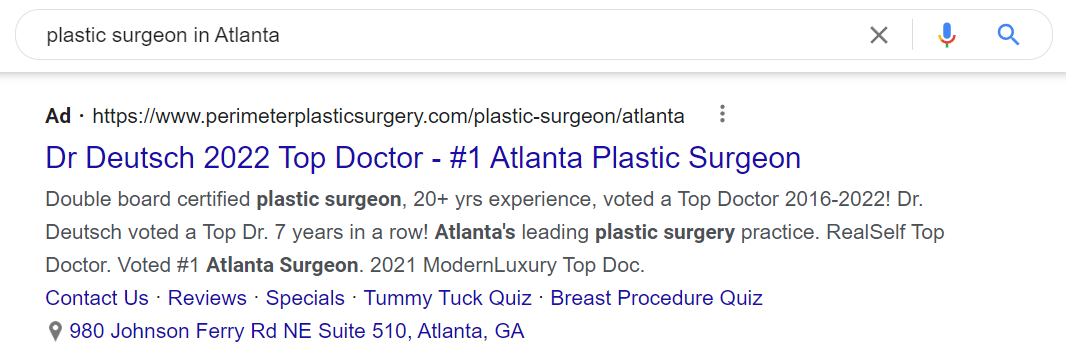
Use paid search to capture bottom-of-the-funnel and middle-of-the-funnel search queries from healthcare consumers ready to buy.
To help you avoid that outcome, here is a five-pronged foundation for improving conversion performance and lead quality while increasing the return on investment (ROI) for your PPC program.
For a more in-depth look into these best practices, check out our article “5 Core Pillars of PPC Strategies that Win New Patients.”
Having a centralized marketing technology system is crucial for the success of a multi-location healthcare organization. It’s essential to track the performance of strategies and their impact on patient outcomes. It allows marketers to streamline operations and save on costs by eliminating unnecessary systems.
Additionally, it makes it simpler to incorporate new acquisitions by having a pre-established technology system and procedures in place. Marketers need to evaluate the effectiveness of their campaigns by looking at metrics such as cost per acquisition, retention rate, and the marketing channels that led to new patients. This is the heart of marketing measurement and using analytics can help healthcare marketers make the most of their budget.
For a deeper understanding of how to successfully measure performance, see our article “How to Measure Healthcare Marketing Performance.”
Conversion rate optimization (CRO) is a process that aims to improve the effectiveness of a healthcare website in converting visitors into patients. It involves more than just making changes to design, analytics, or landing pages. CRO is about understanding what motivates healthcare consumers and using that understanding to create ads, landing pages, and content that appeals to these motivations. By doing so, healthcare providers can influence the actions of their website visitors and encourage them to take actions such as making an appointment or contacting them. In essence, CRO is about understanding human behavior and using that understanding to increase conversions on a healthcare website.
It is beneficial to focus on Conversion Rate Optimization (CRO) as it can lead to significant improvements in the performance of a healthcare website. This marketing strategy can be especially impactful for mature accounts, as it can yield results that surpass those of other media optimizations. Says Rich Briddock, VP Analytics & Paid Media at Cardinal Digital Marketing during an episode of Ignite: Healthcare Marketing Podcast, “it’s absolutely worth it because you can see between two hundred to five hundred percent improvements with a sustained program.”
To learn more, check out our podcast Intro to CRO: How Understanding Human Behavior Can Improve Conversion Rates.
Here are seven ways to start implementing CRO methodologies right now:
Display the book-an-appointment button prominently on ads and websites and make it easy for patients to schedule appointments. The button should be sticky on every webpage and the same color throughout the website, to help train users to take a specific action.
Keep an ear and eye out for common scheduling complaints and invest in tools such as call tracking software to analyze call data and search digital reviews for keywords related to the scheduling experience.
In the end, your ad conversion rate might be suffering because you’re making the audience conform to what you want them to do rather than giving them options.
At a high level, patients have only a handful of needs when they reach a healthcare website. And if those needs aren’t met, user engagement—let alone a conversion—is improbable. In our recent in-depth look at How Patients Choose Healthcare Providers, we discuss these needs in detail, namely:
Ensure that your ads, creative, and landing pages are fast and optimized for mobile devices. You need to have a seamless mobile experience with easy-to-use click-to-call options and optimized online scheduling and forms. If you are not sure if your website is mobile-friendly, try accessing it on your smartphone and see if there are any issues with the mobile user experience.
Having social proof, such as reviews, ratings, and testimonials, is important in the healthcare industry as people tend to choose providers based on them. You should include available social proof in your digital presence, such as on your landing pages and website. Video testimonials are the most effective form of social proof, but photos and quotes also work.
Be clear and specific about the details of each location you have. Your website and landing pages should clearly list all of them, including the doctors, services, and scheduling options available at each one. Avoid any confusion or uncertainty.
In order to effectively communicate important information to healthcare consumers who are searching for answers, present the information in an easy-to-read and well-organized format. This can be achieved by including rich details but presenting them in an organized manner with short headers, subheads, and bullet points.
Limit the length of headings and keep paragraphs and bullet points brief. Highlight key information using pull quotes, statistics, and social proof to make the information stand out.
Read our article 7 Tips for Improving Conversions and Driving More Appointments
The decision of whether to have a branded house or a house of brands is a common topic in the healthcare industry. This is extremely important when consolidating different healthcare groups or adding new brands to an existing group. A branded house approach means that all brands will be unified under one main brand, while a house of brands approach means that each brand will be kept separate and distinct from one another.
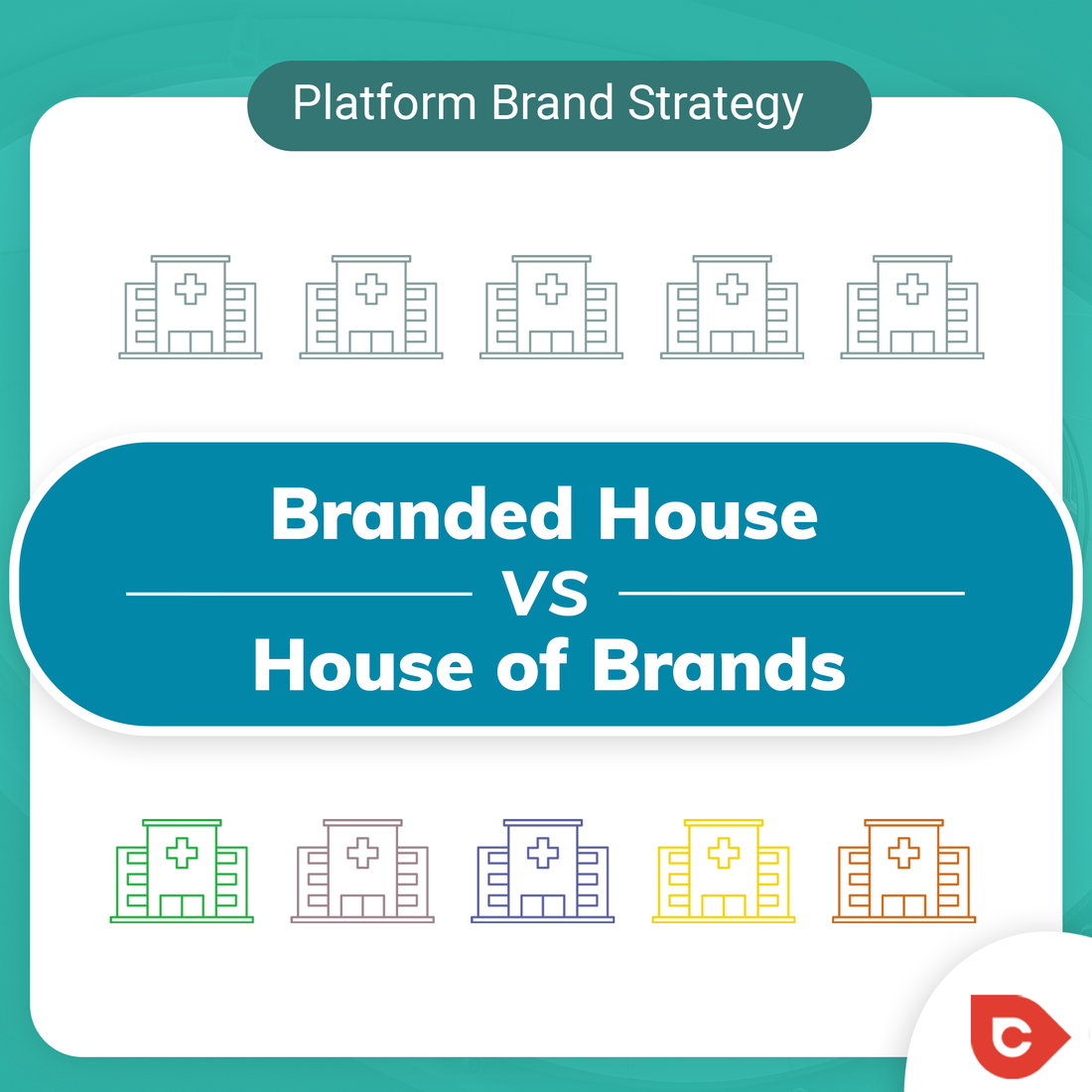
Choosing the “right” brand architecture ultimately depends on a variety of factors, such as the maturity of the market, competition, and the unique characteristics of each brand. Some markets may benefit from a single, unified brand, while others may perform better with separate brand identities. Consider all options and weigh the pros and cons before making a decision, and also keep in mind that the decision doesn’t have to be permanent. As the brand evolves, it may make sense to change the approach.
If you’re still unsure of which architecture style fits your healthcare organization, read our article “MSO Brand Management: One House vs. House of Brands?”
The future of healthcare is digital. While the healthcare industry has been slow to adopt technology due to concerns over patient privacy and established analog processes within organizations, groups are now investing in marketing and patient experience technologies.
Private equity investment and consolidation are fueling technology adoption. To improve efficiency and reduce redundancy, healthcare groups are investing in marketing and patient experience/access technologies, including:
For healthcare organizations with multiple locations, having a centralized call center makes it simpler to answer frequent patient inquiries about insurance, hours of operation, and other related information. A centralized customer relationship management (CRM) system can also greatly improve operations by allowing stakeholders to easily access patient information, share it with patients, and send reminders as needed.
Additionally, using the right CRM system not only increases efficiency but also helps the marketing team to create personalized experiences for patients, resulting in improved patient retention.
Let’s face it if you’re not taking advantage of digital solutions to streamline operations and control your digital presence you may as well be asking for potential patients to pass you by.
Read our article Healthcare Annual Planning for 2023: Time for a Digital Transformation? For more insight into how to make sure your healthcare marketing strategy aligns with the industry’s rapid adoption of digital technology.
If you want to spark seamless growth, your healthcare marketing strategy needs to be completely scalable as you acquire new brands and open new locations. With the increasing reliance on technology and the internet in healthcare, it’s important to have a consistent marketing approach across all locations. A scalable strategy ensures that each location has access to the same resources and can execute the same tactics, while also allowing for local customization to better target specific audiences and address unique challenges.
This helps to maintain a cohesive brand image and ensure that patients receive a consistent level of care and information, no matter which location they visit. By having a scalable digital marketing strategy, multi-location healthcare groups can increase their reach, improve patient engagement, and drive growth.
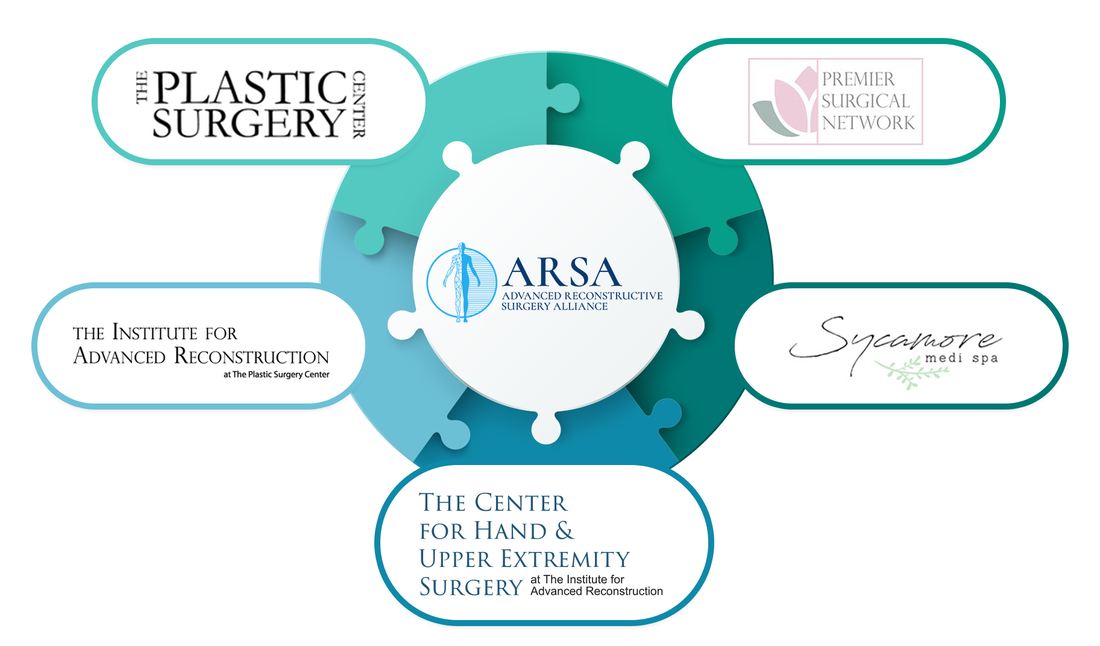
Cardinal collaborated with Reconstructive Surgery Alliance (ARSA) to build a scalable media strategy that could accommodate new brand acquisitions and their ambitious growth goals.
Provider Recruitment
Next to attracting new patients, the biggest challenge for many healthcare groups is provider recruitment. Jobs in the healthcare industry are increasing rapidly and are expected to grow by 13% through 2031.
Provider and healthcare worker shortages have serious implications. Not only will it stall growth and limit your ability to take on new patients, but it can also impact patient care and your brand reputation. The good news? Marketing can make a significant difference by supporting provider recruitment strategies.
Digital marketing can help you raise awareness of your brand on the digital platforms that potential candidates frequently use. Finding the ideal candidates for your healthcare organization isn’t a one-size-fits-all solution. The key to attracting top talent is creating a positive and appealing workplace culture. If your organization already has a great culture and a well-established operational system, don’t keep it a secret. Digital marketing can help you spread the word and attract more top talent. Here are 3 ways healthcare marketers can support and collaborate with recruitment teams to enhance their capabilities, improve patient satisfaction and treatment, and enhance the organization’s image:
It’s crucial to think about the impression that your digital properties make on potential candidates. If a candidate’s first impression of your organization is negative, it will be difficult to convince them to apply.
To ensure that your website and other digital properties effectively showcase your organization and culture, focus on presenting your brand values and culture. Make sure your career page is engaging and informative, highlighting benefits, insurance, time off, and awards. Use photos, videos, and quotes to give applicants a personal and clear understanding of your team and brand ethos. Consider taking inspiration from Cardinal’s About Us and Career pages.
Does your career page struggle with low engagement and high bounce rates? This could be due to a poor user experience. Make sure that the page is easy to navigate, and that the application process is not overly complicated. Remove any obstacles, such as confusing forms, slow-loading pages, or missing information that might be preventing candidates from applying.
As we said before, CRO can help take your healthcare marketing strategy to the next level. To further improve the page’s performance, consider conducting conversion rate optimization (CRO) testing to see if there are any changes that can be made to increase the number of qualified applicants. These tests can help you determine what messaging and information is most compelling to potential hires, and whether offering perks like flexible work hours or work-from-home benefits would attract more applicants.
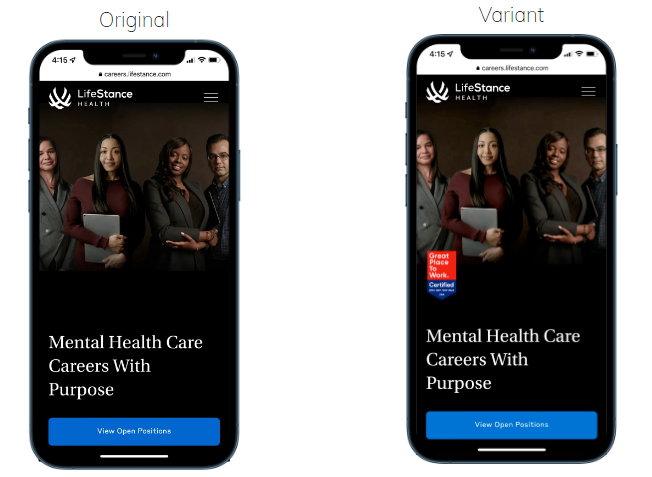
Your reputation matters to potential candidates. They’re looking for signs that you’re a trusted employer. These credibility factors include things like awards, certifications, and employee testimonials. For LifeStance Health, we conducted CRO tests to determine if adding the “Great Place to Work” certification badge to the careers site homepage hero section would improve application CVR.
Advertise to Create Touch Points Along the Job Candidate Journey
Google Ads can be effective in attracting job seekers who are actively searching for new job opportunities. To make the most out of your Google Ad campaign, it’s important to target relevant keywords, have a strong career page, and provide a smooth user experience for applicants. On the other hand, for those who are not actively searching for a job, social media advertising on platforms like Facebook, TikTok, and Instagram can help build brand awareness and a positive image. Video ads can be a powerful tool to show your brand’s culture, happy employees, and positive workplace experiences, making it easier to attract future applicants.
Patient-centric content is crucial for healthcare groups to attract new patients. By focusing on the needs and concerns of patients, healthcare providers can create content that is relevant and helpful to their target audience. This not only improves the user experience, but it also increases the chances that potential patients will find the information they need and choose to visit the provider for their healthcare needs. Additionally, by providing valuable information to potential patients, healthcare providers can establish trust and credibility, which can be key in building strong relationships with new patients.
Healthcare providers should have a comprehensive content strategy in place that addresses the questions and needs of their audience at all stages of the buying process, including the top and middle of the funnel. To optimize their approach, healthcare groups should consider implementing the following strategies:
Adopting a content strategy that prioritizes the needs and concerns of patients can have long-term benefits for healthcare providers. By providing valuable and relevant information to potential patients, healthcare providers can attract new patients and build trust and credibility with them. This approach can ultimately lead to more patients seeking care from the provider and generate sustainable growth for the healthcare group in the long term.
Many people today base their decisions on choosing a healthcare provider on information they find online. This includes visiting the provider’s website and reading reviews from others. According to a study by NRC Health, around 60% of patients have chosen a doctor based on positive reviews they found online. Healthcare brands often fall into the trap of complacency. They concentrate all their marketing efforts on promoting themselves through advertisements and external communications but ignore their online image.
A certain degree of reviews and engagement will naturally occur, but the amount of positive feedback you receive will depend on how established your brand is. Without taking proactive measures to increase positive reviews, you may end up with more negative ones. If not addressed, these negative perceptions can negatively impact your online reputation.
To mitigate this, there are three basic components to a comprehensive online reputation management program. This framework can help you increase patient reviews, enhance your online reputation across various platforms, and prevent negative reviews or a lack of reviews from deterring new patients.
Just like many digital marketing techniques, managing your online reputation starts with identifying what you already have. You need to determine the various digital profiles, websites, channels, and listings associated with your brand, both maintained by you or not. The places where your healthcare consumers go to read and write reviews about your brand should also be taken into consideration. Typically, this list may include the following channels:
Once you have identified all the components of your online presence, the next step is to create a plan to resolve any problems, prioritize what requires updating, and develop a response plan for reviews. It’s important to have clear guidelines that can be standardized and shared throughout your organization. These guidelines should include:
It’s also essential to establish your Google Business listing at minimum. For healthcare practices with multiple locations, set up a listing for each location. Google listings, along with location-specific webpages, play a vital role in managing your online reputation and optimizing your search visibility in local searches.
Have a regular influx of reviews to show that your business is actively engaged with customers and to provide recent feedback for potential patients searching for a new provider.
To gain a consistent and high volume of reviews, it is necessary to have a structured and systematic approach within the organization to collect them. A few key principles of a successful review collecting are:

Automate your review solicitation using tools like Birdeye.
Strengthen your Website Presence
The reputation of a healthcare brand encompasses more than just business listings and online reviews. As previously mentioned, there are multiple ways for patients to reach your website. Regardless of how they arrive at your site, patients expect to find information and content that supports their decision to choose you.
Read our article How to Build a Thriving Digital Reputation for Your Medical Practice to learn more about building a strong, lasting digital presence that drives patient acquisition.
The patient experience now mostly takes place online and has become a crucial aspect in healthcare. With advancements in digital healthcare, patients expect a seamless and hassle-free online experience. In competitive healthcare markets, a positive patient experience can help distinguish a brand, build a good reputation, and gain more referrals.
Here are some surefire ways digital marketing can remove barriers, ease frustrations, and make it easy for patients to get the care they need:
For more insights on how to improve the patient experience, check out our previous webinar Driving Growth with Better Patient Experiences.
As you see, marketing is a vital aspect of the healthcare industry that helps healthcare providers reach and connect with their target audience. With a focus on building a scalable website platform, a strong SEO foundation, and a proficient Google Ads strategy, healthcare providers can increase their online visibility and attract more patients.
The use of marketing technology and analytics, as well as conversion rate optimization, helps healthcare providers track their marketing performance and make informed decisions. Creating patient-centric content, adopting digital, and implementing a provider recruitment strategy, are also key to providing great patient experiences and maintaining a positive reputation. By following these best practices, healthcare providers can increase their success in the competitive world of healthcare marketing.

Alex Membrillo
CEO
The original version of this page was published at: https://www.cardinaldigitalmarketing.com/healthcare-resources/blog/what-is-healthcare-marketing/
As a leading healthcare digital marketing agency, Cardinal Digital Marketing has partnered with some of the most recognizable brands in the country. We’ve helped countless multi-location organizati... Read more
By now, you know that search engine optimization (SEO) is a longer-term play. But you don’t have to be in the dark about the progress of your strategy. That’s the idea ...read more
Labor shortages continue to plague the healthcare industry, stifling growth and damaging the patient experience. We’ve put together tips for how your marketing team can support ...read more
We get it— it’s only natural that healthcare marketers often stay hyper-focused on new patient acquisition. Unfortunately, this stance means that too many groups leave ...read more
Take your patient acquisition to the next level with a smart, efficient, and scalable OB/GYN digital marketing strategy. Put yourself in front of your local audience searching for ...read more